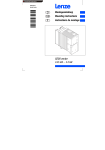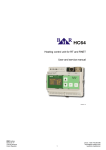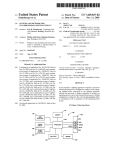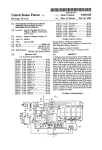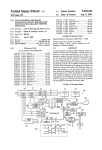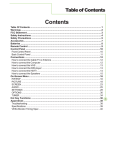Download User Manual - Far West Technology, Inc.
Transcript
INSTRUCTION MANUAL MODEL 6030/6025 LOW LEVEL AREA MONITOR Sept 2000 Version 1 Health Physics Instruments 330 South Kellogg Ave, Suite D Goleta, CA 93117 (805) 967-8422 Division of Far West Technology Fuse at ½ A Slo Blow 5 x 20 mm MODEL 6030 INSTRUCTION MANUAL Low Level Area Monitor PAGE 1 Health Physics Instruments TABLE OF CONTENTS I. II. III. INTRODUCTION ..................................................................................................................... 2 OPERATION 2 INSTALLATION...................................................................................................................... 2 DETECTOR DISPLAY DETECTOR AND DISPLAY CONNECTIONS I/O CONNECTIONS CONNECTOR PART NUMBERS INTERFERENCE CONTACT CLOSURE FOR EXTERNAL ALARM RS232 EXTERNAL INTEGRATOR RESET BUTTON IV. V. FRONT PANEL 4 ALARMS 5 ALARM ACTIVATION ALARM 1 ALARM 2 ALARM 3 FAIL PRIORITY NO ALARM FACTORY SETTINGS CHECK DISPLAY OR VIEWING THE ALARM CONDITIONS VI. APPENDIX I 16 17 17 18 USER TABLES XII. XIII. 14 14 14 14 14 14 15 16 16 CIRCUIT DESCRIPTION........................................................................................................ 16 GENERAL DETECTOR DISPLAY XI. 12 12 MAINTENANCE 14 SHORTCUTS & OPERATIONAL HINTS ZERO DRIFT FUSE LCD CONTRAST DESICCANT FAILURE 1 ADJUSTMENTS MAINTENANCE MODE TESTING DISPLAY X. 11 11 CALIBRATION 12 ZERO ADJUSTMENT CALIBRATION PROCEDURE IX. 8 8 8 8 8 8 9 9 9 10 10 RS232 SERIAL OUTPUT....................................................................................................... 10 STATUS BYTE BIT FUNCTION VIII. 5 5 5 5 5 6 6 6 6 SETUP 7 PRESET ZERO TRIPSET DELAY PAUSE ALM SETUP (ALARM SETUP) BUZZER DECIMAL START TIME FAIL TIME TURNING THE ALARMS OFF VII. 2 3 3 3 3 4 4 4 4 PARTS LIST 20 SCHEMATICS 27 18 MODEL 6030 INSTRUCTION MANUAL Low Level Area Monitor PAGE 2 Health Physics Instruments I. INTRODUCTION The Model 6030/6025 Area Monitor is designed to measure low levels of gamma and neutron radiation. It has several alarms and trip points that are user set. The front panel display shows the radiation level and the status of the instrument. The detector is model number 6030 and the display/readout is model number 6025. II. OPERATION The operation of the 6030/6025 is very simple. The first line of the display shows the radiation level from the detector. It is updated every second. The second line shows the integrated dose and is updated every second. The lights on the front panel also show the status of the alarms. The front panel controls reset the integrated dose, set the alarm levels, and change the operational parameters. When the instrument is first turned on there is a wait until the instrument stabilizes. The number of seconds remaining until normal operation begins is shown on the display along with the version number of the software. The detector may take longer than the wait period to completely stabilize to background levels, however this should not effect the alarms because the level is close to background. III. INSTALLATION The 6030/6025 is easily installed. It consists of 2 parts, the detector unit (6030) and the display or readout unit (6025). There is a single 4 wire connection between the two and a short cable is supplied with the instrument. The detector and display can be remoted up to 100 feet. If you wish to use a longer cable you will need to assemble your own cable. The connectors at each end of the cable are crimp type that can be easily assembled in the field. We recommend Belden 8723 cable. This is a 2 pair shielded cable. For short distances any 4 conductor cable will work. For longer distances or if it is used in a noisy environment we recommend a shielded cable. The connectors are wired the same on both ends of the cable. After setting up the instrument, review the section on ALARMS to know how to change the alarm configurations, on SETUP to know how to change the alarm and zero settings, and on FRONT PANEL to know how to operate the controls on the front panel. DETECTOR The detector is installed by first fixing the detector mounting bracket. The detector unit may be mounted in any orientation. It is best if the side of the detector faces the radiation source. The detector sets into the mounting bracket and is held in place with the two thumbscrews. Plug one end of the cable into the circular connector on top of the detector. MODEL 6030 INSTRUCTION MANUAL Low Level Area Monitor PAGE 3 Health Physics Instruments DISPLAY Plug the cable from the detector into the smaller circular connector on the back of the unit. Plug the power cable into the back of the unit and the other end into the wall (110 VAC 60 Hz). Turn the instrument on using the on-off switch on the back panel of the display. The display should turn on and show the warm-up time counting down. DETECTOR AND DISPLAY CONNECTIONS Small circular connector on the back of the display and on the top of the detector. PIN # DESCRIPTION WIRE COLOR To Display 1 DATA WHITE 2 DATA GREEN 8 +12 VDC RED 9 GROUND BLACK AND SHIELD I/O CONNECTIONS Large circular connector on the back of the display. PIN # DESCRIPTION 1 RELAY N.C. (opens on alarm and power off) RELAY COMMON 2 3 4 RELAY N.O. (closes on alarm and power off) EXTERNAL RESET SWITCH 8 TXD FOR RS232 9 RXD FOR RS232 (Not used) 10 GROUND FOR RS232 13 +12 VOLTS (not used) 14 GROUND for External Reset Switch CONNECTOR PART NUMBERS This table lists the connectors that mate with the connectors in the 6030/6025. All are plastic and made by AMP. PART SMALL CIRCULAR CONNECTOR LARGE CIRCULAR CONNECTOR CONNECTOR PLUG AMP 20678081 13-9 std AMP 206044 17-14 rev CABLE CLAMP AMP 206966-1 AMP 206070-1 CONTACTS AMP 661094 (socket) 661074 (pin) MODEL 6030 INSTRUCTION MANUAL Low Level Area Monitor PAGE 4 Health Physics Instruments INTERFERENCE Interference can cause annoying false alarms. The most likely cause of interference is from noisy AC switches and lamp dimmers. Plugging the offending product into a line filter can often eliminate the interference. CONTACT CLOSURE FOR EXTERNAL ALARM The contact closure from the internal relay is on pins 1,2 and 3 of the large circular connector on the rear of the display. Normally an external alarm would be connected between pin 2 and 3. This alarm operates in the fail-safe mode. If you were to remove power to the display, the relay would open closing contacts on pin 2 and 3. If you are using this relay in a interlock system, connect it between pin 1 and 2. Contacts rated 0.5 A 115 VAC, 1 A 24 VDC resistive. RS232 An RS232 output is available between pin 9 (TXD) and pin 10 (ground) of the large circular connector on the rear of the display. The RXD (pin 8) is not supported with this software. EXTERNAL INTEGRATOR RESET BUTTON If you want an external reset button for the integrate range, connect a N.O. switch between pin 4 and 14 on the large circular connector on the back of the display. Push the button when you want to reset the integrated dose. You should hold the button down for 1 second to assure that the integrate range is reset. To test this connection see Maintenance Mode. IV. FRONT PANEL The front panel of the display contains the LCD display, the alarm LEDs, the beeper, and the four pushbuttons. The LCD shows the radiation level on the top line and the integrated dose on the bottom line. There is a dot on the right hand side of the display that flashes every second to show that the instrument is functioning. There is no overrange indication. The maximum level is shown on the calibration report. There are 4 LED lights along the bottom of the front panel. Their action and colors are from left: unused, red-alarm1, yellow-alarm2, and green-no alarms and no fail. The factory settings use the red LED for the alarm, the yellow LED for a warning and the green LED to indicate that all is OK. The 4 pushbuttons control the setting of the alarms, the fail and turn on delays, and resetting the integrated dose. Pushing the MENU button will cycle through the two possible settings. The first display allows resetting the integrated dose and the second allows setting the alarm levels and other alarm and operational parameters. To reset the dose, push MENU until the display shows “Integrated Dose?” Then push both YES buttons at the same time. The settings menu works the same way. Push MENU until the display shows “SETTINGS?” Then push both YES buttons at the same time. See the section on ALARMS and SETTINGS for more information. MODEL 6030 INSTRUCTION MANUAL Low Level Area Monitor PAGE 5 Health Physics Instruments V. ALARMS There are 4 alarms built into the instrument. All are based on the radiation level and all are adjustable both for the level and for their control over the indicators and relays. The only thing that is not adjustable is their priority. Alarm 1, 2, and 3 all trip if the count level exceeds the alarm setting. The Fail alarm occurs if there are no counts from the detector for a preset time. Each alarm has different settings, and each alarm is designed to look at a different part of the level. Each alarm may be individually turned off if it is not needed by setting the trip level to 0. Alarm 1, 2, and 3 all have several settings associated with them. The different parts of the settings are: 1. TRIP SET This is the alarm level. This setting is a number that is compared with the level from the detector. 2. DELAY alarms. This is the number of intervals that the alarm must be consecutively activated to actually trip the 3. PAUSE This is the number of seconds after the level has decreased below the trip set that the alarm will remain activated. It is used to keep the alarm on longer than one second. It is usually set around 10 seconds. ALARM ACTIVATION Alarms 1, 2, and 3 work in the following manner. When the level rises above the tripset, the delay counts down every interval period from its preprogrammed level. When it reaches zero it turns the alarm on. Until the alarms are activated if the level decreases below the tripset, the delay will reset to its preprogrammed level. This helps to keep noise from tripping the alarm. The pause works like the delay in that it too counts down every second from its preprogrammed level once the level drops below the tripset. When it reaches zero the alarms will be deactivated for that alarm. If other alarms are still activated they will continue to be activate. If during the pause period the level rises above the tripset again, even for one interval, the pause will be reset to the preprogrammed level. Thus once activated the alarms will stay on for at least the pause period following the last occurrence of a trip. This helps to keep the alarms from cycling on and off in a marginal situation. ALARM 1 This alarm has the highest priority. It trips if the level rises above the tripset. It is usually setup to trip the front panel RED LED and to activate the relay and beeper. When tripped it will show ALARM 1 on the second line of the CHECK DISPLAY. It is usually set with the highest alarm level, a short delay and a 10 second pause. ALARM 2 This alarm is identical to alarm 1 except it has the second highest priority. It is usually setup to trip the front panel YELLOW LED and to not activate the relay and beeper. It is used with a short delay and a 10 second pause. When tripped it will show ALARM 2 on the second line of the check display. ALARM 3 This alarm has the third highest priority. It is usually not activated but can be used for any additional configuration. For example, it could be set to a very low level with a long delay to look for slowly changing levels. When tripped it will show ALARM 3 on the second line of the CHECK DISPLAY. FAIL This alarm is used to indicate that the detector is not functioning. It turns off the alarms and indicators and shows FAILURE in the display. It will not activate the relay because there is no known hazard. This alarm will activate if there are no counts from the detector for a number of seconds. The number of seconds is the only setting. When tripped it will show FAIL on the second line of the CHECK DISPLAY. MODEL 6030 INSTRUCTION MANUAL Low Level Area Monitor PAGE 6 Health Physics Instruments PRIORITY The following table shows the priority of the alarms. Alarm 1 has the highest priority which means it will supersede the lower priority alarms. Fail has the lowest priority because if the instrument fails, it obviously has no counts and cannot set the other alarms. Alarm 1 Highest Priority Alarm 2 Alarm 3 Fail Lowest Priority NO ALARM The NO ALARM condition is usually used with the GREEN LED turned on, the relay and beeper turned off and the display showing OK on the second line of the CHECK DISPLAY. FACTORY SETTINGS The following table lists the factory settings for the alarms. ALARM USE DELAY PAUSE YELLOW LED OFF ON GREEN LED OFF OFF RELAY BEEPER 10 10 RED LED ON OFF 1 2 3 FAIL Normal High Levels Warning Not used Detector Failure No Trip 0 0 ON OFF ON OFF N/a N/a N/a N/a OFF OFF OFF OFF OFF ON OFF OFF OFF OFF CHECK DISPLAY OR VIEWING THE ALARM CONDITIONS The CHECK DISPLAY shows the pause and trip status on the 2nd line of the LCD during normal operation by pushing the right hand push-button. When the push-button is down, the status of the three alarms will be displayed on the LCD. When both right hand buttons are pushed at the same time, then the display changes to three groups of characters/digits. Each represents an alarm and are in the following order from left to right: alarm 1, alarm 2, alarm 3 and the fail time. If an alarm is off its values will be displayed as *--. The first character of each group is an ‘*’ if the alarm is not tripped and a ‘T’ if the alarm is tripped. The next number is a 2 digit hex number of either the delay or the pause. If the alarm is not tripped then it is the delay. If the alarm is tripped then it is the pause. This example will use alarm 1. Assume that the delay is set to 5 and the pause is set to 8. Normally, with no trip it would read ‘*05’. The ‘*’ indicates it is not tripped and the ‘05’ is the delay. If the level was brought higher than the tripset then the delay would start to count down every interval period until it reached zero. This shows the delay period. If the level were to decrease below the trip set during the time it was counting down, then the delay would revert back to its level which is 5. When the delay reaches zero, the indicator will change from a ‘*’ to a ‘T’ to indicate it has been tripped, and the alarms will be set. The display will then show ‘T8’ and will continue to show ‘T8’ until the level is brought down below the tripset. When the level is brought below the tripset, the pause will start counting down, decreasing by 1 every second. When it reaches zero, the ‘T’ will change back to a ‘*’ and the alarms will be set to the no alarm condition. The fail time is a hex value of the seconds remaining before the fail mode will be activated. It will start counting down if there is a failure. When it reaches zero it sets the alarms to the fail setting. MODEL 6030 INSTRUCTION MANUAL Low Level Area Monitor PAGE 7 Health Physics Instruments VI. SETUP The instrument has been setup with its preset values. These values are programmed into the EEPROM (changeable permanent memory). They can be changed by the user. This section shows how to change these presets. APPENDIX I contains blank forms for recording your settings. We recommend that you copy this page and use it to figure out your changes. The setup mode is different from the normal operation of the instrument. To enter into the setup mode first push MENU twice then the two YES buttons at the same time. NOTE: To exit this mode, keep pushing the MENU button until you have cycled through all of the choices. The buttons on the control panel will do the following: MENU (left hand button) will bring up the next item to adjust. Repeatedly pushing the MENU button will cycle through all the adjustments. RESET (left of center button) is not used. UP(right of center button) will move the arrow on the bottom line from one digit to the next. Every time it is pushed the arrow will move left to the next digit. When it gets to the last digit it will jump to the first digit. DOWN (far right hand button) will increment the digit that the arrow points to. Every time the button is pushed the digit will increase. It only takes a few seconds of playing with the buttons to understand how they function. Some adjustments have 3 digits and some have 4. The adjustments with 3 digits have a maximum setting of 255. If they are set above 255 they will actually be set to 255. The bottom line of the display reminds you that they have a maximum value of 255. The four digit adjustments have no restrictions, they can be adjusted from 00.00 to 99.99. Repeatedly pushing the MENU button will cycle the display through all of the adjustments. After the last adjustment the program will go back to normal operation. Most of the settings are saved in EEPROM after the last item which is the fail-safe time, consequently if you are part way through changing the settings and decide you don’t want the new values you can turn power off then back on or if the top cover is removed push the reset button (S1) which is under the ribbon cable to the display. The following is a list of the parameters in the order that they are seen on the display along with the factory presets. The letters A1, A2 etc. refer to alarm 1, alarm 2 etc. DELAY A2 is the delay value for alarm 2. Presets @255 ZERO TRIPSET 1 TRIPSET A2 TRIPSET A3 DELAY A1 DELAY A2 DELAY A3 PAUSE A1 PAUSE A2 PAUSE A3 Alm Setup A1 Alm Setup A2 Alm Setup A3 No alm Setup Start Time Fail Time 60 1.00 0.80 0 1 1 10 10 10 10 137 137 4 2 255 100 Please read the section on the alarms to become familiar with the action of the alarms. All of the parameters are reviewed below. You must cycle through all of the parameters to get back to a normal display. MODEL 6030 INSTRUCTION MANUAL Low Level Area Monitor PAGE 8 Health Physics Instruments PRESET Set this value to 255 if you want all of the adjustments to be reset to their factory preset values. If you do not want the factory preset settings, then push MENU again to go to the next item. ZERO This is the value that is subtracted from the reading from the detector. The level in the detector is elevated above zero. See the calibration section. TRIPSET This is the alarm level. This setting is a 4 digit number that is compared with the reading from the detector. DELAY This is the number of intervals that the alarm must be consecutively activated to actually trip the alarms. PAUSE This is the number of seconds after the level has decreased below the trip set that the alarm will remain activated. It is used to keep the alarm on longer than one interval. It is usually set around 10 seconds. It can be set longer but it usually is determined by how long the beeper (or external alarm) needs to be on to arouse someone that there is a problem. ALM SETUP (ALARM SETUP) This is a number that is used to set the condition of the alarms, indicators and external outputs. There are 4 setups, one for each of the three alarms and one for no alarms. Below is a description of the alarms, indicators and external outputs. Each can be set to only two values, 0 or 1. Following the descriptions is the method used to calculate the values and to determine the decimal value. RELAY This controls the relay. The contacts of the relay are brought out to the large circular connector. When the relay is set to 0, the relay is closed. When the relay is 1, the relay is open. The relay is operated in the fail-safe mode (OFF actually energizes the relay). The signal to control the relay is also routed to pin 8 on P4 on the main circuit board in the display. P4:5 This is pin 5 on plug P4 which is located on the main circuit board in the display. When the relay is set to 1 then this pin is high. This pin has no normal function and is not used in normal operation of the monitor. P4:6 This is pin 6 on plug P4 which is located on the main circuit board in the display. When P4:6 is set to 1 then this pin is high. This pin has no normal function and is not used in normal operation of the monitor. P4:7 This is pin 7 on plug P4 which is located on the main circuit board in the display. When P4:7 is set to 1 then this pin is high. This pin has no normal function and is not used in normal operation of the monitor. P4:8 MODEL 6030 INSTRUCTION MANUAL Low Level Area Monitor PAGE 9 Health Physics Instruments This is pin 8 on plug P4 which is located on the main circuit board in the display. When P4:7 is set to 1 then this pin is high. This pin has no normal function and is not used in normal operation of the monitor. RED LED This is the front panel red LED. If the RED LED is set to 1 then the LED is on. YELLOW LED This is the front panel yellow LED. If the YELLOW LED is set to 1 then the LED is on. GREEN LED This is the front panel green LED. If the GREEN LED is set to 1 then the LED is on. BUZZER This is the front panel buzzer. If BUZZER is set to 1 then the buzzer is turned on and emits a loud continuous beep. DECIMAL The following table is a compilation of the settings of all the parts of the alarm setup. The value is a decimal value that is calculated from the results of the table. The line of one’s and zero’s on a row is actually a binary number. This number is converted to decimal and that is the decimal number. For example the first line of the table below shows: alarm * * * 0 11 0 0 If you change the * to zeros it becomes the number 00001100. This is a binary number. To find its decimal equivalent, look at the binary to decimal conversion table in the appendix. Look at the first binary column from the left and about 13 numbers down. You should find the number 00001100. Next to it is the number 12. This is the decimal conversion. 0001100 in binary is 12 in decimal. This decimal number is the number you enter into the alarm setup. The following is a table that shows the normal operation of the instrument as it is setup using the factory presets. P4:8 P4:7 P4:6 BEEPER * RELAY and P4:5 0 1 RED LED 1 YELLOW LED 0 GREEN LET 0 DECIMAL VALUE 12 Alarm 1 * * Alarm 2 * * * 1 0 0 1 0 18 Alarm 3 * * * 1 0 0 0 0 16 No Alarm * * * 1 0 0 0 1 17 FAIL 0 0 0 1 0 0 0 0 16 • *Setting does not matter for normal operation. We suggest each of these be set to 0. The decimal calculations assume that the items marked * are set to 0. FAIL is only show for information purposes, it is not changeable. START TIME When the instrument is turned on it waits before going into normal operation. This gives time for the instrument to stabilize. The display shows the seconds counting down until normal operation. The start time is the starting number for the countdown. It can also be thought of as the start delay. If it is set to a low number the detector may not stabilize in time causing the alarms to trip. MODEL 6030 INSTRUCTION MANUAL Low Level Area Monitor PAGE 10 Health Physics Instruments FAIL TIME If the display does not receive a signal from the detector it will show a failure in the display. The fail time is the number of seconds after the last signal before the instrument will activate the failure mode. If the fail time is set to 60 seconds, it will take 60 seconds after the detector fails before the instrument will display FAILURE. The factory setting is 30. The detector should send a signal representing 0.01 mR/h at least every second if it is operating normally. TURNING THE ALARMS OFF Each of the alarms can be turned off. To turn off alarm 1, 2 or 3, set the tripset to zero. VII. RS232 SERIAL OUTPUT The serial output only sends RS232 data. It does not receive data. SIGNON MESSAGE At turn-on the instrument sends a signon message then a packet of data. The message is: HPI 6030 VER 1.0 000064 000050 000000 00 00 00 00 00 00 The version number of the software is shown on the first line. The data on the second line from left to right: 1 XXXXXX 3 hex digits Alarm trip level for alarm 1 space 2 XXXXXX 3 hex digits Alarm trip level for alarm 2 space 3 XXXXXX 3 hex digits Alarm trip level for alarm 3 space 4 XX XX 2 hex digits separated by a space. The first is the delay. The second is the pause. Both are for alarm 1. space 5 XX XX 2 hex digits separated by a space. The first is the delay. The second is the pause. Both are for alarm 2 space 6 XX XX 2 hex digits separated by a space. The first is the delay. The second is the pause. Both are for alarm 3 SERIAL STREAM Every second the display sends out a packet of data via the RS232 serial output. The packet is the data at the time it was sent and should look like: 000001 0000000000 00 the data from left to right is: 1 XXXXXX 3 hex digits Counts per second from detector. The same value as on the display. When converted to decimal add decimal point 2 digits from the right: X.XX mR/h. MODEL 6030 INSTRUCTION MANUAL Low Level Area Monitor PAGE 11 Health Physics Instruments 2 XXXXXXXXXX 5 hex digits integrated dose. When converted to decimal add decimal point 2 digits from the right: X.XX mR. 3 XX 1 hex digit This is the status byte. See below for a description. STATUS BYTE The status byte consists of 8 bits. The bits are represented as follows: Bit 0 is the LSB and bit 7 is the MSB. Only bits 0 thru 4 are used. Use the lookup table in the appendix to change from hex to binary. BIT FUNCTION 0 1 2 3 0=no trip, 1=trip for alarm 1 0=no trip, 1=trip for alarm 2 0=no trip, 1=trip for alarm 3 0=no fail, 1=fail MODEL 6030 INSTRUCTION MANUAL Low Level Area Monitor PAGE 12 Health Physics Instruments VIII. CALIBRATION The instrument has three adjustments for calibration, two are for the zero and the other is the calibration adjust. ZERO ADJUSTMENT The detector is biased above zero, i.e. when it is exposed to no radiation it still sends a signal to the display. The display digitally subtracts a zero offset value from this level. This is the value that is shown on the LCD. It is possible to show the level without the zero offset subtracted from the reading by pushing the right hand button and holding it down. The level on the top line is the level without the zero subtracted. The right hand number on the bottom line is the zero offset value. It can be changed through the setup menu. The factory setting is 0.60 mR/h. There are two ways to approach the zero adjustment. The first is to adjust the zero offset in the SETUP menu to the factory setting of 0.60 mR/h then adjust the zero trimmer in the detector until the normal display shows a value above zero, then to slowly back it off to zero. The second is to leave the zero adjustment in the detector where it is and adjust the zero offset in the display until the display shows zero. There is some noise on the signal and either adjustment is made to just eliminate any reading when the detector is not exposed to any radiation. It is a good idea to monitor the zero for a few minutes to make sure it is correct. We recommend a combination of the two. First set the zero offset in the display to 0.60 mR/h. Then adjust the zero trimmer in the detector until the display just reads zero most of the time. Then use the zero offset as a fine adjustment if you need to. The zero offset in the display should be set somewhere from 0.30 to 0.80 mR/h. If it is set too low then the fail may not work properly. If it is set too high then the reading may drift. Remember that if the instrument is reset to the factory settings then the zero offset will be set to 0.60 mR/h. You can check the zero adjustment by integrating for several hours in the Maintenance Mode. The integrated dose (mR) will show you where the zero is set because Maintenance Mode removes the zero offset from both the rate and integrate ranges. It is always best to let the instrument sit for several hours before adjusting the zero. CALIBRATION PROCEDURE Figure 1 shows the locations of the adjustments on the circuit board in the detector housing. 1. Connect the display to the detector and turn the instrument on. Wait for the stabilization period to end. 2. Check and adjust zero by adjusting either the zero in the detector or the zero offset in the display or both. See the ZERO ADJUSTMENT section above. 3. Expose the detector to a known quantity of radiation. Adjust the calibration adjust in the detector until the reading in the CHECK DISPLAY is the correct value. 4. Check zero and readjust if necessary. Alternate between step 2 and 3 until both zero and the calibration are correct. 5. Check at least 1 point on every decade. (1, 10, 100 mR/h) 6. Continue to expose the detector to higher and higher levels until the display reaches a maximum, usually from 100 to 300 mR/h. Note this maximum level on the calibration report. 7. The integrate range should be checked. Do not exceed the maximum dose rate. There are 2 ways to check this range. The first is to turn time the source and the second is to time the exposure after the instrument is reading the correct rate. For the first method of timing the source, wait for the exposure rate to drop to zero before starting the exposure (and timer). After the timer has timed out and exposure stopped, wait for the exposure rate on the display to return to 0 before taking the exposure numbers from the display. You want the ramp up and down. MODEL 6030 INSTRUCTION MANUAL Low Level Area Monitor PAGE 13 Health Physics Instruments For the second method, expose the instrument to the calibrated rate and wait for the rate display to stabilize. Reset the integrated dose and start your timer. When the time is up, read the dose on the fly. Figure 1 Calibration And Zero Adjustment Locations MODEL 6030 INSTRUCTION MANUAL Low Level Area Monitor PAGE 14 Health Physics Instruments IX. MAINTENANCE This section discusses the circuit of the instrument and any adjustments that may be needed. It also describes a test mode for checking out the instrument. SHORTCUTS & OPERATIONAL HINTS The 6030/25 has several shortcuts. Push the RESET button on the front panel of the display during the warm-up period to cancel the warm-up period. Pushing the right hand button during normal operation to see the status and to see the zero offset. Pushing the two right hand buttons together during normal operation to show the status of the alarms and fail. Push the RESET button on the control panel during normal operation to cancel the local buzzer. Push the DOWN BUTTON and keeping it on during power up will enter the maintenance mode. If you have the complete cover off of the display, the reset button (S1) on the top of the circuit board can be used to abort the setup routine. Just push it while in the setup routine. You can also abort the setup routine by turning off the power. If you are testing the alarms and the noise is too loud, put a piece of tape over the beeper. It will not make it quiet but it will reduce the volume. ZERO DRIFT If you notice the zero drifting change the zero offset in the SETUP Menu to compensate. Remember you want the reading on the display to read zero most of the time if there is only background radiation. You can see where the zero is by looking at the CHECK DISPLAY. It is best to let the instrument warm up for a day or so before adjusting zero. FUSE The fuse is located in the socket for the line cord. Remove the line cord and pry out the fuse holder. Replace the fuse with a 5 x 20 mm fuse rated at ½ A slow blow. Fast-acting will also work in an emergency however we have found that they occasionally blow because of the type of load. LCD CONTRAST The LCD contrast is on the large circuit board in the display. Remove the top cover and turn R2 to adjust the contrast. It is located under the ribbon cable that goes to the LCD display . DESICCANT The desiccant is inside the electrometer housing in the detector box. It only needs to be replaced if the zero is excessively high or erratic. FAILURE 1 If the display should show FAILURE 1 this indicates that the eeprom is defective and that all of the settings including the alarm levels and zero offset may be corrupted. You can try to re-program the eeprom to the factory settings by pushing MENU. This will change the display to the setup menu. Then try setting the preset settings. If it still shows FAILURE 1 then replace the eeprom and repeat with the factory settings. MODEL 6030 INSTRUCTION MANUAL Low Level Area Monitor PAGE 15 Health Physics Instruments ADJUSTMENTS The zero and gain adjustments for the detector are covered in the calibration section. HIGH VOLTAGE ON DETECTOR CIRCUIT BOARD The high voltage for the detector is adjusted on the circuit board with R37 to –800 volts. Use a high impedance voltmeter (>10E12 ohm) to measure the voltage at the junction of C27 and R30. NEGATIVE VOLTAGE ON DETECTOR CIRCUIT BOARD The negative voltage for the preamp electrometer is adjusted to 0.1 volt. Place a voltmeter between ground and pin 6 of U9. Adjust R26 until the voltage is 0.1 volt. P O W E R S U P P L Y R E A DJ U S T M E N T The 12 VDC 110/220 Volt power supply located under the circuit board in the display is readjusted for an output of 11 volts. This reduces the power dissipation of the regulators on the display and detector boards. Figure 2 Adjustment Locations MODEL 6030 INSTRUCTION MANUAL Low Level Area Monitor PAGE 16 Health Physics Instruments MAINTENANCE MODE This is a special display that allows you to monitor the rate, integrate, maximum and minimum level of the detector. Use this mode to check the zero reading from the display. You can enter this mode and let it sit for a day or two to check both the maximum and minimum level. This shows if there is excessive noise in the display. The integrated dose can also show if the average is too high. Remember to mentally subtract the zero offset from the readings, both rate and integrate. To enter into Maintenance Mode, hold down the DOWN button while you turn on the display. The display shows the radiation level on the top line of the LCD followed by the maximum level since reset. The bottom line shows the integrated dose followed by the minimum level since reset. The radiation level, and minimum and maximum levels all read in mR/h. The integrated dose is in mR. All levels are actual levels without the zero offset subtracted from the readings. When the external integrate reset button is pushed, the lower right hand digit will change to a *. Pushing RESET will reset the minimum and maximum levels. Pushing the UP button will activate the relay. Pushing the MENU button will cycle through the alarms and annunciators. TESTING DISPLAY The display alarms and annunciators can be tested by pushing down the MENU button on the front panel. When it is held down the instrument will cycle through 10 different annunciators in the following order: Green LED Yellow LED Red LED Front panel buzzer Relay and P4:5 All off P4:6 P4:7 P4:8 All lights on The cycle will then repeat as long as the MENU button is held down. (P4 is not available except on the circuit board.) X. CIRCUIT DESCRIPTION GENERAL The detector sends a frequency to the display that depends on the radiation level. The frequency can vary from 0 to about 20,000 Hz. Each Hz represents 0.01 mR/h. The zero of the electrometer is also biased up from absolute zero. Thus with no radiation the detector has a signal of 0.60 mR/h. A frequency of 360 Hz from the detector is thus displayed as 3.00 mR/h; 360 is 3.60 mR/h and subtract the zero offset of .60 results in 3.00. The signal between the detector and the display is based on a RS485 driver and is a complimentary signal, i.e. both signal lines change state. MODEL 6030 INSTRUCTION MANUAL Low Level Area Monitor PAGE 17 Health Physics Instruments DETECTOR The detector measures a small amount of current from the ion chamber and creates a frequency output. The detector needs a high voltage supply to function properly. The detector V1 is a 3 liter three terminal ion chamber. Ionizing radiation produces ion pairs inside the detector that are collected on the center signal portion of the detector. This current is integrated onto U101, an electrometer amplifier with a high value feedback resistor (R101). The negative ion chamber current makes the output of the electrometer move positive. The input filter C104 and R 103 smooth any peak transients from pulsed radiation. The output of the electrometer goes from 0 volt to 4 volts. U1 acts as a buffer amplifier and it buffers the voltage to frequency converter U2. The output of U2 goes to U4:A which is a pulse generator. The pulse from U4:A is sent to the 75176 line driver and then to the cable to the readout. The high voltage power supply is a switching type generating -800 volts. U10 is an oscillator that feeds the one-shot U10B. The output of this one-shot turns on Q2 creating a pulse in the primary of T1. The secondary of T2 feeds a voltage quadrupler. The high voltage is measured by U11:A which turns the one-shot on and off to regulate the voltage. R48, R30 and C27 and C37 form a filter to remove any ripple from the high voltage. U11:B monitors the high voltage and turns off the output signal if the HV falls too low. DISPLAY The display measures the frequency from the detector, subtracts background using software, and sets the alarms and relays according to the settings in memory. It contains the line power supply to power the detector and itself. The display is controlled by the microprocessor, U3. U1 is an address latch that separates the address and data. U5 is the LCD display. U2 is the EEPROM that stores the variables. U8 is the address decoder for the LCD and for the input latch U19 and the output latch U18. The relay is connected directly to the microprocessor through U9:D and Q1. This is done to make the relay fail-safe. If the microprocessor is reset either by power on or by the watchdog timer U4, then the output pin P33 (~INT) will float high opening the relay. U7 is a space for extra RAM should it be needed. U12 and U13 are RS232 and RS485 outputs respectively. U18 is an output latch that feeds the output buffers U16 and U17 this drives the front panel LED’s. U19 is an input latch for the pushbuttons and for the external reset switch. U21 is an A/D converter. U24 is a DAC. The incoming pulses from the detector go to U26 and then to the microprocessor U3 where they are counted. R1 adjusts the contrast. U4 is a watchdog timer for the MPU and it needs a pulse on P1.0 (clock) at least every second to keep the watchdog from timing out and resetting the microprocessor. U10 is a 5 volt regulator and U11 generates a negative 5 volts for the LCD. U20 is an optocoupler that separates the external reset signal from the internal circuit board. It is used to reset the integrator. MODIFICATIONS Not all of the parts on the circuit board and schematic are included in this model. They are included for future changes or to allow this circuit board to be used in different ways The detector board has a place for U14, a microprocessor. The designators marked A on the circuit boards are the same as designators marked without an A. The display has more options. It includes jumpers for RS232 and RS485 inputs and outputs on both the communications lines and the data lines from the detectors. The lines from the detector are designed to accept pulses or serial data from the detector. The watchdog can be disabled by removing JP1. This board also contains an ACD, a DAC, and extra outputs and inputs that are not used. You may want to consult the factory if you need any of these enabled or changed because several are software dependent. MODEL 6030 INSTRUCTION MANUAL Low Level Area Monitor PAGE 18 Health Physics Instruments XI. APPENDIX I USER TABLES The blank tables below are useful to determine how you want the alarms setup. Copy it and fill it out not only for ease of programming, but also for your records. DATE______________ SERIAL NUMBER____________ __________________ LOCATION ________________________BY_______________________________ ALARM SETUP P4:7 P4:6 P4:5 RELAY BEEPER RED LED YELLOW LED GREEN LET DECIMAL VALUE Alarm 1 1 Alarm 2 2 Alarm 3 3 No Alarm 4 ENTER THE DECIMAL NUMBERS FROM THE DECIMAL VALUE BOXES ABOVE INTO THE SETUP BOXES BELOW SUMMARY OF SETTINGS TRIPSET DELAY PAUSE SETUP ALARM 1 1 ALARM 2 2 ALARM 3 3 NO ALARM 4 START TIME _________ FAIL TIME _________ MODEL 6030 INSTRUCTION MANUAL Low Level Area Monitor .APPENDIX II DECIMAL/HEX/BINARY CONVERSION TABLE DEC HEX BINARY 0 00 00000000 1 01 00000001 2 02 00000010 3 03 00000011 4 04 00000100 5 05 00000101 6 06 00000110 7 07 00000111 8 08 00001000 9 09 00001001 10 0A 00001010 11 0B 00001011 12 0C 00001100 13 0D 00001101 14 0E 00001110 15 0F 00001111 16 10 00010000 17 11 00010001 18 12 00010010 19 13 00010011 20 14 00010100 21 15 00010101 22 16 00010110 23 17 00010111 24 18 00011000 25 19 00011001 26 1A 00011010 27 1B 00011011 28 1C 00011100 39 1D 00011101 30 1E 00011110 31 1F 00011111 32 20 00100000 33 21 00100001 34 22 00100010 35 23 00100011 36 24 00100100 37 25 00100101 38 26 00100110 39 27 00100111 40 28 00101000 41 29 00101001 42 2A 00101010 43 2B 00101011 44 2C 00101100 45 2D 00101101 46 2E 00101110 47 2F 00101111 48 30 00110000 49 31 00110001 50 32 00110010 51 33 00110011 52 34 00110100 53 35 00110101 54 36 00110110 55 37 00110111 56 38 00111000 57 39 00111001 58 3A 00111010 59 3B 00111011 60 3C 00111100 61 3D 00111101 62 3E 00111110 63 3F 00111111 64 40 01000000 65 41 01000001 66 42 01000010 67 43 01000011 68 44 01000100 69 45 01000101 70 46 01000110 71 47 01000111 72 48 01001000 73 49 01001001 74 4A 01001010 75 4B 01001011 76 4C 01001100 77 4D 01001101 78 4E 01001110 79 4F 01001111 80 50 01010000 81 51 01010001 82 52 01010010 83 53 01010011 84 54 01010100 85 55 01010101 86 56 01010110 87 57 01010111 88 58 01011000 89 59 01011001 90 5A 01011010 91 5B 01011011 92 5C 01011100 93 5D 01011101 94 5E 01011110 95 5F 01011111 96 60 01100000 97 61 01100001 98 62 01100010 99 63 01100011 100 64 01100100 101 65 01100101 102 66 01100110 103 67 01100111 104 68 01101000 105 69 01101001 106 6A 01101010 107 6B 01101011 108 6C 01101100 109 6D 01101101 110 6E 01101110 111 6F 01101111 112 70 01110000 113 71 01110001 114 72 01110010 115 73 01110011 116 74 01110100 117 75 01110101 118 76 01110110 119 77 01110111 120 78 01111000 121 79 01111001 122 7A 01111010 123 7B 01111011 124 7C 01111100 125 7D 01111101 126 7E 01111110 127 7F 01111111 PAGE 19 Health Physics Instruments 128 129 130 131 132 133 134 135 136 137 138 139 140 141 142 143 144 145 146 147 148 149 150 151 152 153 154 155 156 157 158 159 160 161 162 163 164 165 166 167 168 169 170 171 172 173 174 175 176 177 178 179 180 181 182 183 184 185 186 187 188 189 190 191 80 81 82 83 84 85 86 87 88 89 8A 8B 8C 8D 8E 8F 90 91 92 93 94 95 96 97 98 99 9A 9B 9C 9D 9E 9F A0 A1 A2 A3 A4 A5 A6 A7 A8 A9 AA AB AC AD AE AF B0 B1 B2 B3 B4 B5 B6 B7 B8 B9 BA BB BC BD BE BF 10000000 10000001 10000010 10000011 10000100 10000101 10000110 10000111 10001000 10001001 10001010 10001011 10001100 10001101 10001110 10001111 10010000 10010001 10010010 10010011 10010100 10010101 10010110 10010111 10011000 10011001 10011010 10011011 10011100 10011101 10011110 10011111 10100000 10100001 10100010 10100011 10100100 10100101 10100110 10100111 10101000 10101001 10101010 10101011 10101100 10101101 10101110 10101111 10110000 10110001 10110010 10110011 10110100 10110101 10110110 10110111 10111000 10111001 10111010 10111011 10111100 10111101 10111110 10111111 192 193 194 195 196 197 198 199 200 201 202 203 204 205 206 207 208 209 210 211 212 213 214 215 216 217 218 219 220 221 222 223 224 225 226 227 228 229 230 231 232 233 234 235 236 237 238 239 240 241 242 243 244 245 246 247 248 249 250 251 252 253 254 255 C0 C1 C2 C3 C4 C5 C6 C7 C8 C9 CA CB CC CD CE CF D0 D1 D2 D3 D4 D5 D6 D7 D8 D9 DA DB DC DD DE DF E0 E1 E2 E3 E4 E5 E6 E7 E8 E9 EA EB EC ED EE EF F0 F1 F2 F3 F4 F5 F6 F7 F8 F9 FA FB FC FD FE FF 11000000 11000001 11000010 11000011 11000100 11000101 11000110 11000111 11001000 11001001 11001010 11001011 11001100 11001101 11001110 11001111 11010000 11010001 11010010 11010011 11010100 11010101 11010110 11010111 11011000 11011001 11011010 11011011 11011100 11011101 11011110 11011111 11100000 11100001 11100010 11100011 11100100 11100101 11100110 11100111 11101000 11101001 11101010 11101011 11101100 11101101 11101110 11101111 11110000 11110001 11110010 11110011 11110100 11110101 11110110 11110111 11111000 11111001 11111010 11111011 11111100 11111101 11111110 11111111 MODEL 6030 INSTRUCTION MANUAL Low Level Area Monitor PAGE 20 Health Physics Instruments XII. Parts List The designators marked A on the circuti boards are the same as designators marked without an A. DISPLAY READOUT DESIGNATOR QUAN R1 R2 R3 R4 R5 R6 R7 R8 R9 R10 R11 R12 R13 R14 R15 R16 R17 R18 R19 R20 R21 R22 R23 R24 R25 R26 R27 R28 R29 R30 R31 R32 R33 R34 R35 R36 R37 R38 R39 R40 R41 R42 R43 R44 R45 R46 R47 R48 1 1 1 0 0 1 0 0 0 0 0 0 0 0 0 1 1 1 1 1 1 1 1 1 1 1 0 1 1 0 0 0 0 0 0 0 0 0 0 0 0 0 0 0 0 0 0 0 PART VALUE NUMBER 10K 20K 10K 1K 0 Ohm 0 Ohm 0 Ohm 0 Ohm 1K 10K 1K 1K 1K 1K 1K 1K 10K 510 DESCRIPTION Resistor Network, 1/4W, 5%, CF Trimmer, 1T Resistor, 1/4W, 5%, CF Resistor, 1/4W, 5%, CF Resistor, 1/4W, 5%, CF Resistor, 1/4W, 5%, CF Resistor, 1/4W, 5%, CF Resistor, 1/4W, 5%, CF Resistor, 1/4W, 5%, CF Resistor, 1/4W, 5%, CF Resistor, 1/4W, 5%, CF Resistor, 1/4W, 5%, CF Resistor, 1/4W, 5%, CF Resistor, 1/4W, 5%, CF Resistor, 1/4W, 5%, CF Resistor, 1/4W, 5%, CF Resistor, 1/4W, 5%, CF Resistor, 1/4W, 5%, CF Resistor, 1/4W, 5%, CF Resistor network, 1/4W, 5%, CF Resistor, 1/4W, 5%, CF Resistor, 1/4W, 5%, CF Resistor, 1/4W, 5%, CF Resistor, 1/4W, 5%, CF Resistor, 1/4W, 5%, CF Resistor, 1/4W, 5%, CF Resistor, 1/4W, 5%, CF Resistor, 1/4W, 5%, CF Resistor, 1/4W, 5%, CF Resistor, 1/4W, 5%, CF Resistor, 1/4W, 5%, CF Resistor, 1/4W, 5%, CF Resistor, 1/4W, 5%, CF Resistor, 1/4W, 5%, CF Resistor, 1/4W, 5%, CF Resistor, 1/4W, 5%, CF Resistor, 1/4W, 5%, CF Resistor, 1/4W, 5%, CF Resistor, 1/4W, 5%, CF Resistor, 1/4W, 5%, CF Resistor, 1/4W, 5%, CF Resistor, 1/4W, 5%, CF Resistor, 1/4W, 5%, CF Resistor, 1/4W, 5%, CF Resistor, 1/4W, 5%, CF Resistor, 1/4W, 5%, CF Resistor, 1/4W, 5%, CF Resistor, 1/4W, 5%, CF MFG DRAWING NO. SBC3-001 Display SBC3-001 Display SBC3-001 Display SBC3-001 Display SBC3-001 Display SBC3-001 Display SBC3-001 Display SBC3-001 Display SBC3-001 Display SBC3-001 Display SBC3-001 Display SBC3-001 Display SBC3-001 Display SBC3-001 Display SBC3-001 Display SBC3-001 Display SBC3-001 Display SBC3-001 Display SBC3-001 Display SBC3-001 Display SBC3-001 Display SBC3-001 Display SBC3-001 Display SBC3-001 Display SBC3-001 Display SBC3-001 Display SBC3-001 Display SBC3-001 Display SBC3-001 Display SBC3-001 Display SBC3-001 Display SBC3-001 Display SBC3-001 Display SBC3-001 Display SBC3-001 Display SBC3-001 Display SBC3-001 Display SBC3-001 Display SBC3-001 Display SBC3-001 Display SBC3-001 Display SBC3-001 Display SBC3-001 Display SBC3-001 Display SBC3-001 Display SBC3-001 Display SBC3-001 Display SBC3-001 Display MODEL 6030 INSTRUCTION MANUAL Low Level Area Monitor DESIGNATOR QUAN R49 R50 R51 R52 R53 R54 R55 0 0 0 0 0 1 0 C1 C2 C3 C4 C5 C6 C7 C8 C9 C10 C11 C12 C13 C14 C15 C16 C17 C18 C19 C20 C21 C22 C23 C24 C25 C26 C27 C28 1 1 1 1 1 0 0 1 1 1 1 1 1 0 0 0 0 0 0 0 0 0 0 0 0 0 0 0 CX1 CX2 CX3 CX4 CX5 CX6 CX7 CX8 CX9 CX10 1 1 1 1 1 1 1 1 1 1 D1 D2 D3 D4 D5 D6 0 0 0 0 1 1 PAGE 21 Health Physics Instruments PART VALUE NUMBER MFG DRAWING NO. Resistor, 1/4W, 5%, CF Resistor, 1/4W, 5%, CF Resistor, 1/4W, 5%, CF Resistor, 1/4W, 5%, CF Resistor, 1/4W, 5%, CF Resistor, 1/4W, 5%, CF Resistor, 1/4W, 5%, CF SBC3-001 Display SBC3-001 Display SBC3-001 Display SBC3-001 Display SBC3-001 Display SBC3-001 Display SBC3-001 Display 22 pF 22 pF 0.47 uF 470 uF 33 uF Capacitor, mono ceram Capacitor, mono ceram Capacitor, mono ceram Capacitor, Electro Capacitor, Tantalum 33 uF 33 uF 1 uF 1 uF 1 uF 1 uF Capacitor, Tantalum Capacitor, Tantalum Capacitor, Tantalum Capacitor, Tantalum Capacitor, Tantalum Capacitor, Tantalum SBC3-001 Display SBC3-001 Display SBC3-001 Display SBC3-001 Display SBC3-001 Display SBC3-001 Display SBC3-001 Display SBC3-001 Display SBC3-001 Display SBC3-001 Display SBC3-001 Display SBC3-001 Display SBC3-001 Display SBC3-001 Display SBC3-001 Display SBC3-001 Display SBC3-001 Display SBC3-001 Display SBC3-001 Display SBC3-001 Display SBC3-001 Display SBC3-001 Display SBC3-001 Display SBC3-001 Display SBC3-001 Display SBC3-001 Display SBC3-001 Display SBC3-001 Display 0.1 uF 0.1 uF 0.1 uF 0.1 uF 0.1 uF 0.1 uF 0.1 uF 0.1 uF 0.1 uF 0.1 uF Capacitor, mono ceram Capacitor, mono ceram Capacitor, mono ceram Capacitor, mono ceram Capacitor, mono ceram Capacitor, mono ceram Capacitor, mono ceram Capacitor, mono ceram Capacitor, mono ceram Capacitor, mono ceram SBC3-001 Display SBC3-001 Display SBC3-001 Display SBC3-001 Display SBC3-001 Display SBC3-001 Display SBC3-001 Display SBC3-001 Display SBC3-001 Display SBC3-001 Display Diode, fast switching Diode, fast switching SBC3-001 Display SBC3-001 Display SBC3-001 Display SBC3-001 Display SBC3-001 Display SBC3-001 Display 100K 1N4148 1N4148 DESCRIPTION MODEL 6030 INSTRUCTION MANUAL Low Level Area Monitor DESIGNATOR QUAN D7 D8 D9 D10 D11 D12 D13 D14 D15 D16 D17 D18 D19 D20 D21 D22 D23 D24 D25 D26 D27 1 1 1 1 1 1 1 1 1 1 1 1 1 1 0 0 0 0 0 0 0 Q1 1 U1 U2 U3 U4 U5 1 1 1 1 1 PART VALUE NUMBER 1N4148 1N4148 1N4148 1N4148 1N4148 1N4148 1N4148 1N4148 1N4148 1N4148 1N4148 1N4148 1N4148 1N4148 PAGE 22 Health Physics Instruments DESCRIPTION MFG DRAWING NO. Diode, fast switching Diode, fast switching Diode, fast switching Diode, fast switching Diode, fast switching Diode, fast switching Diode, fast switching Diode, fast switching Diode, fast switching Diode, fast switching Diode, fast switching Diode, fast switching Diode, fast switching Diode, fast switching SBC3-001 Display SBC3-001 Display SBC3-001 Display SBC3-001 Display SBC3-001 Display SBC3-001 Display SBC3-001 Display SBC3-001 Display SBC3-001 Display SBC3-001 Display SBC3-001 Display SBC3-001 Display SBC3-001 Display SBC3-001 Display SBC3-001 Display SBC3-001 Display SBC3-001 Display SBC3-001 Display SBC3-001 Display SBC3-001 Display SBC3-001 Display IRF530 FET, Power, N channel SBC3-001 Display Octal Latch EEPROM 8 Bit Microprocessor Supervisor/Watchdog LCD 2 x 16 Supertwist W/Backlight SBC3-001 Display SBC3-001 Display SBC3-001 Display SBC3-001 Display SBC3-001 Display U11 U12 U13 U14 U15 U16 74HC573 24C02 80C31BH MAX813L DMC16202NY LY 1 27C256 W/Program 0 1 74HC139 1 74HC00 1 LM29405.0 1 ICL7660 1 MAX232 0 0 0 1 DS2003 U17 U18 U19 U20 U21 U22 U23 U24 U25 U26 0 1 1 1 0 0 0 0 0 1 U6 U7 U8 U9 U10 Maxim Optrex EPROM SBC3-001 Display Address Latch Quad NAND Gate Volt Regulator SBC3-001 Display SBC3-001 Display SBC3-001 Display SBC3-001 Display Volt Generator RS232 Driver/PS Buffer 74HC574 74HC573 4N32P Octal Latch Octal Latch Optocoupler 4013B Flip Flop National Semi Maxim National Semi SBC3-001 Display SBC3-001 Display SBC3-001 Display SBC3-001 Display SBC3-001 Display SBC3-001 Display SBC3-001 Display SBC3-001 Display SBC3-001 Display SBC3-001 Display SBC3-001 Display SBC3-001 Display SBC3-001 Display SBC3-001 Display SBC3-001 Display SBC3-001 Display MODEL 6030 INSTRUCTION MANUAL Low Level Area Monitor DESIGNATOR QUAN U27 U28 0 0 S1 K1 X1 1 1 1 X2 0 PAGE 23 Health Physics Instruments PART VALUE NUMBER DESCRIPTION MFG DRAWING NO. SBC3-001 Display SBC3-001 Display EVQ G5V-1 7.3728 MHz Switch, Momentary Relay, SPDT Crystal Omron SBC3-001 Display SBC3-001 Display SBC3-001 Display SBC3-001 Display DETECTOR VFC BOARD DESIGNATOR QUAN R1 R2 R3 R4 R5 R6 R7 R8 R9 R10 R11 R12 R13 R14 R15 R16 R17 R18 R19 R20 R21 R22 R23 R24 R25 R26 R27 R28 R29 0 0 1 0 1 0 1 1 0 0 0 0 0 1 1 R30 R31 R32 R33 R34 R35 R36 1 1 1 1 1 0 1 PART VALUE NUMBER 10 Ohm 10 Ohm 100K 8.06K 8.06K 100K 1 1 0 0 0 1 1 0 1 1 1 0 0 10K 1.5K 2K 2K 10 Ohm 100K 100K MOX300 MOX300 100 Ohm 200M 430K 2.7K 1K 200M 499K DESCRIPTION MFG Resistor, 1/4W, 5%, CF Resistor, 1/4W, 5%, CF Resistor, 1/4W, 5%, CF Resistor, 1/4W, 5%, CF Resistor, 1/4W, 5%, CF Resistor, 1/4W, 5%, CF Trimmer, 20T, Top, 3/8 Resistor, 1/4W, 1%, MF Resistor, 1/4W, 5%, CF Resistor, 1/4W, 5%, CF Resistor, 1/4W, 5%, CF Resistor, 1/4W, 5%, CF Resistor, 1/4W, 5%, CF Resistor, 1/4W, 1%, MF Trimmer, 20T, Top, 3/8 Resistor, 1/4W, 5%, CF Resistor, 1/4W, 5%, CF Resistor, 1/4W, 5%, CF Resistor, 1/4W, 5%, CF Resistor, 1/4W, 5%, CF Resistor, 1/4W, 5%, CF Resistor, 1/4W, 5%, CF Resistor, 1/4W, 5%, CF Resistor, 1/4W, 5%, CF Resistor, 1/4W, 5%, CF Trimmer, 20T, Top, 3/8 Resistor, 1/4W, 5%, CF Resistor, 1/4W, 5%, CF Resistor, 1/4W, 5%, CF Resistor, 1/4W, 5%, CF Resistor, 1/4W, 5%, CF Resistor, 1/4W, 5%, CF Resistor, 1/4W, 5%, CF Resistor, 1/4W, 5%, CF Resistor, 1/4W, 5%, CF Resistor, 1/4W, 1%, MF DRAWING NO. 6030U-001 6030U-001 6030U-001 6030U-001 6030U-001 6030U-001 6030U-001 6030U-001 6030U-001 6030U-001 6030U-001 6030U-001 6030U-001 6030U-001 6030U-001 6030U-001 6030U-001 6030U-001 6030U-001 6030U-001 6030U-001 6030U-001 6030U-001 6030U-001 6030U-001 6030U-001 6030U-001 6030U-001 6030U-001 Victoreen Victoreen 6030U-001 6030U-001 6030U-001 6030U-001 6030U-001 6030U-001 6030U-001 MODEL 6030 INSTRUCTION MANUAL Low Level Area Monitor DESIGNATOR QUAN R37 R38 R39 R40 R41 R42 R43 R44 R45 R46 R47 R48 R49 1 1 1 0 0 0 0 0 0 0 0 1 1 R50 R51 1 1 C1 C2 C3 C4 C5 C6 C7 C8 0 1 1 1 1 1 1 1 C9 C10 C11 C12 C13 C14 C15 C16 C17 C18 C19 C20 C21 C22 C23 1 1 0 0 1 1 0 1 1 1 0 1 1 1 1 C24 C25 1 1 C26 1 C27 1 C28 1 C29 C30 0 1 PAGE 24 Health Physics Instruments PART VALUE NUMBER 100K 51K 100K DESCRIPTION MFG DRAWING NO. Trimmer, 20T, Top, 3/8 Resistor, 1/4W, 5%, CF Resistor, 1/4W, 5%, CF Resistor, 1/4W, 5%, CF Resistor, 1/4W, 5%, CF Resistor, 1/4W, 5%, CF Resistor, 1/4W, 5%, CF Resistor, 1/4W, 5%, CF Resistor, 1/4W, 5%, CF Resistor, 1/4W, 5%, CF Resistor, 1/4W, 5%, CF Resistor, 1/4W, 5%, CF Resistor, 1/4W, 5%, CF 6030U-001 6030U-001 6030U-001 6030U-001 6030U-001 6030U-001 6030U-001 6030U-001 6030U-001 6030U-001 6030U-001 6030U-001 6030U-001 Resistor, 1/4W, 5%, CF Resistor, 1/4W, 5%, CF 6030U-001 6030U-001 0.1 uF 10 uF 0.1 uF 0.1 uF 0.1 uF 0.1 uF 0.022 uF 0.01 uF 0.01 uF Capacitor, mono ceram Cpacitor, Tantalum Capacitor, mono ceram Capacitor, mono ceram Capacitor, mono ceram Capacitor, polypropelyne Capacitor, polypropelyne 6030U-001 6030U-001 6030U-001 6030U-001 6030U-001 6030U-001 6030U-001 6030U-001 0.1 uF 0.1 uF Capacitor, mono ceram Capacitor, mono ceram 1000 uF 0.1 uF 0.1 uF Capacitor, Electrolytic Capacitor, mono ceram Capacitor, mono ceram 100 uF 0.1 uF 100 uF 0.022 uF 3kV 100 uF 0.022 uF 3kV 0.022 uF 3kV 0.022 uF 1.6kV 0.022 uF 3kV Capacitor, Tantalum Capacitor, mono ceram Capacitor, Tantalum Capacitor, Disc Ceram 6030U-001 6030U-001 6030U-001 6030U-001 6030U-001 6030U-001 6030U-001 6030U-001 6030U-001 6030U-001 6030U-001 6030U-001 6030U-001 6030U-001 6030U-001 Capacitor, Tantalum Capacitor, Disc Ceram 6030U-001 6030U-001 Capacitor, Disc Ceram 6030U-001 Capacitor, Polyproplene 6030U-001 Capacitor, Disc Ceram 6030U-001 Capacitor, mono ceram 6030U-001 6030U-001 10M 100 Ohm 100K 100K 0.001 uF Capacitor, polypropelyne Capacitor, mono ceram MODEL 6030 INSTRUCTION MANUAL Low Level Area Monitor PAGE 25 Health Physics Instruments DESIGNATOR QUAN PART VALUE NUMBER 100 pF DESCRIPTION C31 C32 C33 C34 C35 C36 C37 1 0 1 0 0 0 1 Capacitor, mono ceram 0.1 uF Capacitor, mono ceram 0.05 uF 1.6kV Capacitor, Polyproplene CX1 CX2 1 1 0.1 uF 0.1 uF Capacitor, mono ceram Capacitor, mono ceram D1 D2 D3 D4 D5 D6 D7 D8 D9 D10 D11 D12 0 0 0 0 1 1 1 1 0 0 0 0 FR107 FR107 FR107 FR107 1 kV 1 kV 1 kV 1 kV Rectifier, Fast recovery Rectifier, Fast recovery Rectifier, Fast recovery Rectifier, Fast recovery T1 1 6030-T1 Transformer U1 U2 1 1 TLC271CP VFC121 Op Amp Volt to Freq Converter U3 U4 U5 U6 U7 U8 U9 U10 U11 U12 U13 U14 U15 1 1 1 1 1 1 1 1 1 0 0 0 0 75176 4538 LM2940 LM336-2.5 LM336-2.5 ICL7660 TLC271CP ICL7665 TLC27M2 RS485 Line Driver/Rcvr Dual Mono Volt Reg Volt Reference 2.5 V Volt Reference 2.5 V Volt Converter Op Amp Dual Timer Dual Op Amp MFG DRAWING NO. 6030U-001 6030U-001 6030U-001 6030U-001 6030U-001 6030U-001 6030U-001 6030U-001 6030U-001 6030U-001 6030U-001 6030U-001 6030U-001 6030U-001 6030U-001 6030U-001 6030U-001 6030U-001 6030U-001 6030U-001 6030U-001 6030U-001 6030U-001 HPI Burr Brown 6030U-001 6030U-001 6030U-001 6030U-001 6030U-001 6030U-001 6030U-001 6030U-001 6030U-001 6030U-001 6030U-001 6030U-001 6030U-001 6030U-001 6030U-001 6030U-001 PREAMP ELECTROMETER BOARD DESIGNATOR QUAN R101 1 R102 R103 R104 1 1 0 PART VALUE NUMBER 104 5x 10E10 Ohm 10 Ohm MOX300 1000M DESCRIPTION MFG DRAWING NO. Hi Meg Resistor Eltec 6030-006 Resistor, 1/4W, 5%, CF Resistor, 1/4W, 5%, CF Victoreen 6030-006 6030-006 6030-006 MODEL 6030 INSTRUCTION MANUAL Low Level Area Monitor PAGE 26 Health Physics Instruments R105 R106 R107 R108 R109 R110 0 1 1 0 0 0 C101 C102 C103 C104 C105 C106 C107 1 1 1 1 1 1 1 U101 1 LMC6041 Op Amp U102 0 4052B SS Switch Q101 0 10 Ohm 100.0K Resistor, 1/4W, 5%, CF Resistor, 1/4W, 1%, MF 0.1 uF 100 pF 10 uF 1000 pF 0.1 uF 0.1 uF 10 uF Capacitor, Mono Ceram Capacitor, Polystyrene Capacitor, Tantalum Capacitor, Polystyrene Capacitor, Mono Ceram Capacitor, Mono Ceram Capacitor, Tantalum 6030-006 6030-006 6030-006 6030-006 6030-006 6030-006 6030-006 6030-006 6030-006 6030-006 6030-006 6030-006 6030-006 National Semi 6030-006 6030-006 6030-006 DETECTOR CHASSIS DESIGNATOR QUAN M1 M2 M3 M4 M5 M6 M7 M8 1 1 1 1 1 1 1 1 M9 M10 M11 M12 M13 M14 1 1 1 1 1 2 PART VALUE NUMBER 6030-M1 6030-M2 6030-M3 6030-M4 1055-6030 6030-M6 6030-M7 6030-M8 6030-M9 6030-M10 6030-M11 6030-M12 6030-M13 6030-M14 DESCRIPTION MFG DRAWING NO. MFG DRAWING NO. Chassis Back Cover Chassis Suround Chassis Front Cover Electrometer Box with Cover Detector Detector Mounting Detector Straps Electrometer Circuit Board Complete VFC Circuit Board Complete Cable Electrometer to VFC Cable VFC to Circular Chassis Desiccant Mounting Bracket Thumbscrews READOUT CHASSIS DESIGNATOR QUAN M1 M2 M3 M4 M5 1 1 1 1 1 PART VALUE NUMBER 6025-M1 6025-M2 6025-M3 6025-M4 6025-M5 M6 M7 1 1 6025-M6 6025-M7 DESCRIPTION Chassis Back Cover Chassis Bottom Cover Chassis Front Cover Chassis Top Cover Power Supply w/MOV and Jumpers for 110VAC SBC3 Large Circuit Board LCD Display MODEL 6030 INSTRUCTION MANUAL Low Level Area Monitor DESIGNATOR QUAN M8 M9 M10 M11 M12 M13 RX1 1 1 1 1 1 1 1 D1 D2 D3 Dx blank 1 1 1 1 PART VALUE NUMBER 6025-M8 6025-M9 6025-M10 6025-M11 6025-M12 6025-M13 100 Ohm 6025-M14 Red 6025-M15 Yellow 6025-M16 Green 6025-M17 M14 M15 M16 M17 1 1 1 1 6025-M18 6025-M15 6025-M16 6025-M17 M18 F1 1 1 6025-M18 6025-M19 XIII. SCHEMATICS The Schematics are on the following pages. PAGE 27 Health Physics Instruments DESCRIPTION Push Button Circuit Board Buzzer Line Cord Line Recepticle w/Fuse Holder Power Switch Rear Panel I/O Connector Resistor 5W LED Annunciator w/Circuit Board LED Annunciator w/Circuit Board LED Annunciator w/Circuit Board BLANK LED Annunciator wo/Circuit Board Wiring Harness w/Connectors Cable LCD to Display PCB Cable Push Button to Display PCB Cable LED Annunciators to Display PCB Cable 6025 to 6030 6' Long Fuse 1/2 A 5 x 20 mm MFG DRAWING NO.





























